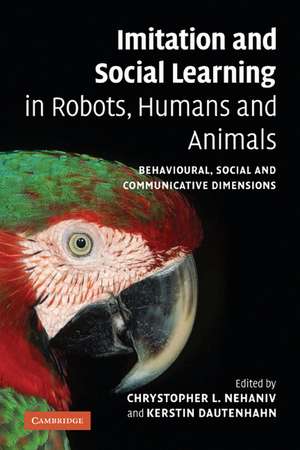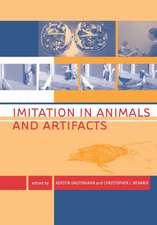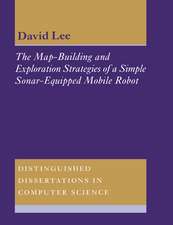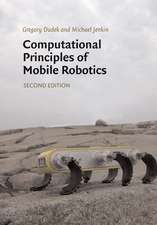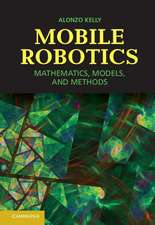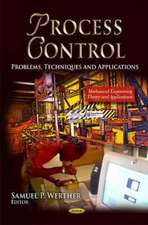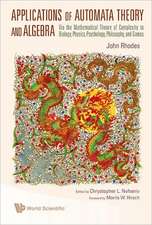Imitation and Social Learning in Robots, Humans and Animals: Behavioural, Social and Communicative Dimensions
Editat de Chrystopher L. Nehaniv, Kerstin Dautenhahnen Limba Engleză Paperback – 8 apr 2009
Preț: 456.76 lei
Nou
Puncte Express: 685
Preț estimativ în valută:
87.41€ • 94.92$ • 73.43£
87.41€ • 94.92$ • 73.43£
Carte tipărită la comandă
Livrare economică 22 aprilie-06 mai
Preluare comenzi: 021 569.72.76
Specificații
ISBN-13: 9780521108638
ISBN-10: 0521108632
Pagini: 508
Ilustrații: 77 b/w illus. 20 colour illus. 5 tables
Dimensiuni: 152 x 229 x 29 mm
Greutate: 0.74 kg
Editura: Cambridge University Press
Colecția Cambridge University Press
Locul publicării:Cambridge, United Kingdom
ISBN-10: 0521108632
Pagini: 508
Ilustrații: 77 b/w illus. 20 colour illus. 5 tables
Dimensiuni: 152 x 229 x 29 mm
Greutate: 0.74 kg
Editura: Cambridge University Press
Colecția Cambridge University Press
Locul publicării:Cambridge, United Kingdom
Cuprins
Introduction: The constructive interdisciplinary viewpoint for understanding mechanisms and models of imitation and social learning Kerstin Dautenhahn and Chrystopher L. Nehaniv; Part I. Correspondence Problems and Mechanisms: 1. Imitation: thoughts about theories Geoffrey Bird and Cecilia Heyes; 2. Nine billion correspondence problems Chrystopher L. Nehaniv; 3. Challenges and issues faced in building a framework for conducting research in learning from observation Darrin Bentivegna, Christopher Atkeson and Gordon Cheng; Part II. Mirroring and 'Mind-Reading': 4. A neural architecture for imitation and intentional relations Marco Iacoboni, Jonas Kaplan and Stephen Wilson; 5. Simulation theory of understanding others: a robotics perspective Yiannis Demiris and Matthew Johnson; 6. Mirrors and matchings: imitation from the perspective of mirror-self-recognition and the parietal region's involvement in both Robert W. Mitchell; Part III. What to Imitate: 7. The question of 'what to imitate': inferring goals and intentions from demonstrations Malinda Carpenter and Josep Call; 8. Learning of gestures by imitation in a humanoid robot Sylvain Calinon and Aude Billard; 9. The dynamic emergence of categories through imitation Tony Belpaeme, Bart de Boer and Bart Jansen; Part IV. Development and Embodiment: 10. Copying strategies by people with autistic spectrum disorder: why only imitation leads to social cognitive development Justin H. G. Williams; 11. A bayesian model of imitation in infants and robots Rajesh P. N. Rao, Aaron P. Shon and Andrew N. Meltzoff; 12. Solving the correspondence problem in robotic imitation across embodiments: synchrony, perception and culture in artefacts Aris Alissandrakis, Chrystopher L. Nehaniv and Kerstin Dautenhahn; Part V. Synchrony and Turn-Taking as Communicative Mechanisms: 13. How to build an imitator? Arnaud Revel and Jacqueline Nadel; 14. Simulated turn-taking and development of styles of motion Takashi Ikegami and Hiroki Iizuka; 15. Bullying behaviour, empathy and imitation: an attempted synthesis Kerstin Dautenhahn, Sarah N. Woods and Christina Kaouri; Part VI. Why Imitate? Motivations: 16. Multiple motivations for imitation in infancy Mark Nielsen and Virginia Slaughter; 17. The progress drive hypothesis: an interpretation of early imitation Frédéric Kaplan and Pierre-Yves Oudeyer; Part VII. Social Feedback: 18. Training behaviour by imitation: from parrots to people … to robots? Irene M. Pepperberg and Diane V. Sherman; 19. Task learning through imitation and human-robot interaction Monica N. Nicolescu and Maja J. Mataric; Part VIII. The Ecological Context: 20. Emulation learning: the integration of technical and social cognition Ludwig Huber; 21. Mimicry as deceptive resemblance: beyond the one-trick ponies Mark D. Norman and Tom Tregenza.
Recenzii
'Imitation and Social Learning in Robots, Humans, and Animals advances our understanding of the diversity of “imitations” and how much is to be learned from comparing them across species as diverse as parrots, butterflies, and even a male cuttlefish impersonating a female in a breeding pair – and thence to humans and their primate cousins and the brain mechanisms which support imitation and social learning. This book offers a rich set of processing strategies of importance to key areas of computer science, like robotics and embodied communication - and this new understanding factors back into novel theories of human social interaction and its disorders.' Michael Arbib, University Professor, Fletcher Jones Chair in Computer Science and Professor of Biological Sciences and Biomedical Engineering, University of Southern California
'Imitation has become the hottest of multidisciplinary topics in recent years. Nehaniv and Dautenhan have led the way in recognising the very special potential for cross-fertilisation between engineers endeavouring to create truly imitative robots and researchers studying imitation in natural systems, from parrots to people. In this substantial new state-of-the-art volume, they bring together leading figures to provide an unprecedented appraisal of the key issues and the most recent discoveries in this field.' Andrew Whiten, Wardlaw Professor of Psychology, University of St Andrews
'Imitation has become the hottest of multidisciplinary topics in recent years. Nehaniv and Dautenhan have led the way in recognising the very special potential for cross-fertilisation between engineers endeavouring to create truly imitative robots and researchers studying imitation in natural systems, from parrots to people. In this substantial new state-of-the-art volume, they bring together leading figures to provide an unprecedented appraisal of the key issues and the most recent discoveries in this field.' Andrew Whiten, Wardlaw Professor of Psychology, University of St Andrews
Descriere
A unique, interdisciplinary study into the field of imitation and social learning in robots, humans and animals.
